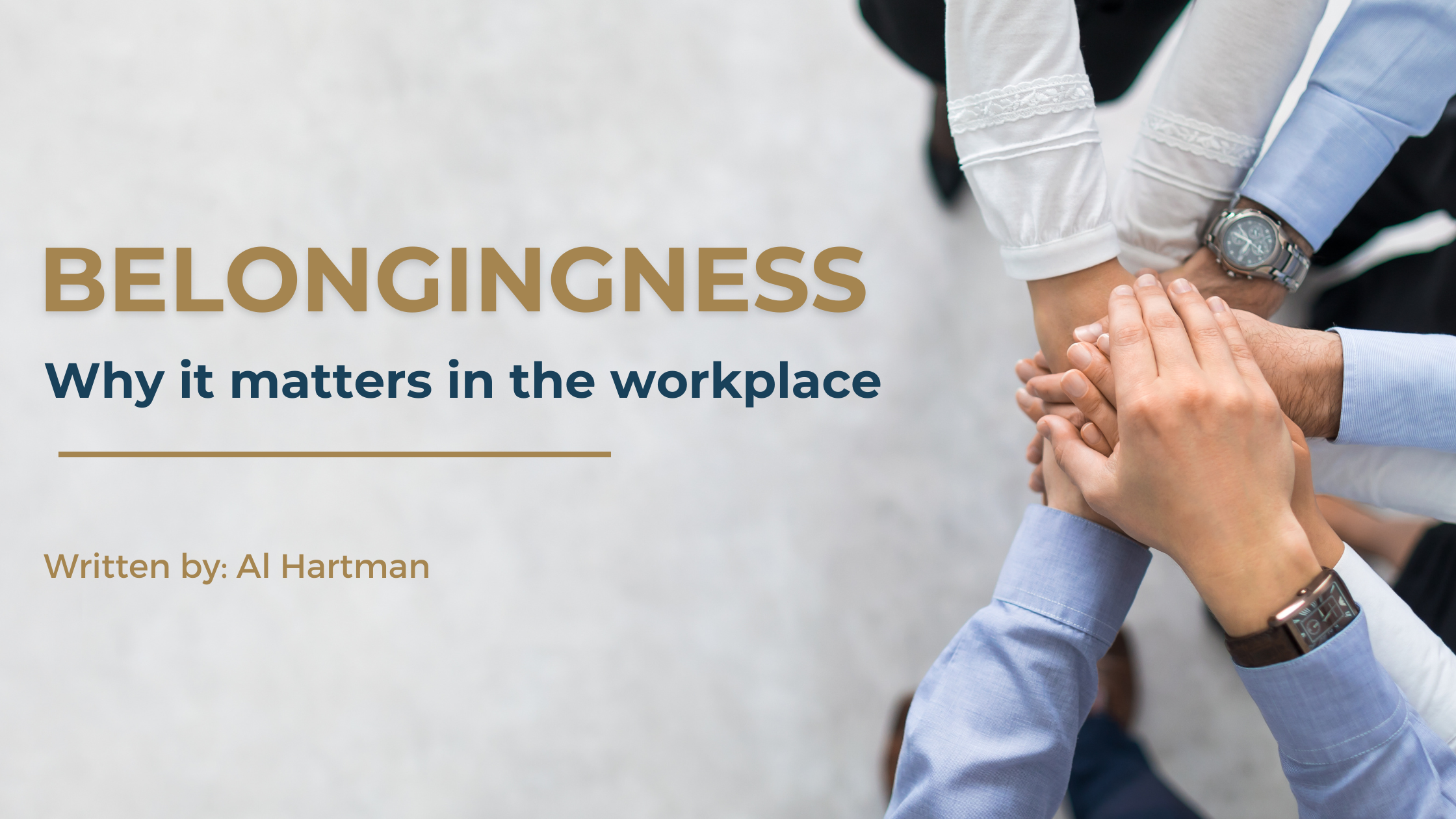We all want to belong.
Belongingness is a core desire shared by every human being on the planet.

At Hartman, we’ve sought to create a culture that fulfills this need in a meaningful way.
Malcolm Gladwell said it best, “It’s very hard to feel necessary when you are physically disconnected.”
We find an evidence-based definition of this dynamic helpful:
When employees feel belongingness in their jobs and workplace, it will transform a company’s culture, working environment, and employee retention due to increased employee satisfaction.
You’ll notice that both Malcolm Gladwell and Al Hartman share a perspective:
Belongingness is best achieved when we are physically together, sharing the same space.
Gladwell goes so far as to say that a work from home arrangement is destructive. Research and surveys point to decreased mental health and a struggle to maintain a healthy company culture when everyone works remotely.
The leadership team at Hartman would like to suggest that our highest goals of a closely knit community are only achieved when we work together, in the same building, interacting every day.
This paper will make a case for that, and we hope to convince you of the compelling value of working in the office to support our need to belong.
Why is the Feeling of Belongingness Important in the Workplace?
“The need to belong, also known as belongingness, refers to a human emotional need to affiliate with and be accepted by members of a group. This may include the need to belong to a peer group at school, to be accepted by co-workers, to be part of an athletic team, or to be part of a religious group.”
Source: Verywell Mind
This inherent emotional need is what drives us to aspire to societally affirmed goals, even extending to our place of work.
While familial bonds are imperative, so are the bonds we make in our communities, in our neighborhoods and, yes, at work.
Most of us spend the majority of our waking hours at work, and it should be a place that not only encourages skill-building and a sense of accomplishment but a place we feel “at home away from home.” The people are what make this feeling happen. People like us.
At Hartman, we are eager to impart the importance of this idyll: that work can not only be a place to perform, but a place to belong.
Establishing Belongingness in the Workplace
In a Harvard business review on the “Power of Asking Coworkers How They’re Doing,” survey respondents indicated that people who feel belongingness in the workplace are 3.5 times more likely to contribute to their fullest potential. They are also measurably more productive, more motivated, and more engaged.
The impact of belonging goes beyond benefits to individual employees. It has the power to affect a company to its core.
This is one of the many reasons we strive at Hartman to uphold a Stage 5 culture. This cultural precedent is shaped by Tribal Leadership, a book by Dave Logan, John King, and Halee Fischer-Wright. No matter how long you have worked with Hartman, you know this ethos is vital to our organization.
Our goal is to progressively upgrade our organizational culture, acknowledging the power of “tribes,” or smaller communities within our larger community.
People naturally gravitate towards each other. They naturally exhibit leadership qualities and influence. When each tribe is healthy, and positive traits are upheld and affirmed, the company as a whole can grow toward unity.

This doesn’t mean we are all the same, rather that we are wholly focused on our goals and efforts that achieve the collective goal. What’s more, in this model, we all have a natural fit and a place to belong. It diminishes conflict and creates space for everyone to belong.
How to Increase Belongingness in the Workplace
At risk of having painted a utopian ideal that lives only hypothetically, we want to turn now to the practicalities.
How do we increase belongingness in the workplace?
What follows are ways we can all contribute to a workplace typified by belongingness.
1. Adhere to Our Core Values
Malcolm Gladwell said, “If we don’t feel like we are part of something, what’s the point?” That is salient, and a reminder that we must be on mission. Al Hartman’s earliest days of building the company we work in today included an important core value, which is also a guiding value in his approach to leadership:
“We honor God in all we do by operating the company in a manner consistent with biblical principles.”
This value is exemplified by the offering of weekly Bible studies to those who are interested in learning about Christ and studying the Bible. The validity of the value we state and restate is that we pair it with relevant application.
We also have several other core values that you’ve probably heard many times. Our goal is to repeat them often and for you to see them lived out here at work each day.
2. Reinvest in Our Community
Investing in a local community is a way of giving back. Because community means different things to different people, this can be as simple as participating in a local food drive, and as big as providing hurricane relief to those affected by the storm, just as we did during hurricane Harvey in 2017.
Part of belonging at Hartman is a giving heart and attitude. We are always observing needs in the community. We are always helping others out, and bonding over our shared willingness to go above and beyond, to be servant-minded, and open-hearted to any and everyone in need.
3. Give Everyone a Voice
We’ve talked a couple of times about how belongingness has two layers: it is helpful for individuals and helpful for the group. An essential component of putting this into practice is giving everyone a voice.
People are encouraged here. They are affirmed. Their good deeds and behaviors are noticed and publicly praised. Sometimes even in monetary form, also known as a “coin.” If we “catch you” being great at what you do, we will recognize your work.
4. Commit to Growth
A threat to belongingness is rigid hierarchy, closely followed by a reluctance to hear challenging things or acknowledge weakness. Here, we do not believe you must be perfect. You simply must be present and you must be coachable.
We perform at a high level, in part because we spur one another on toward love and good deeds and excellence.
At its core, this represents a commitment to growth. On every level, for every team member, we are ever-improving. This is a safe space to not have all of the answers, but to avidly seek them and apply fresh practices to improve your personal and professional performance.
Leaders have open doors and open minds and we love the fact that we are on a journey together, sharing and cooperating and always believing the best is yet to come.
For these four factors, you will notice a theme: they are only achieved in physical proximity, when we are physically together.
It’s an important theme to emphasize:
The vast majority of the efforts that promote and protect belongingness take place in person.
How Employees Can Establish Belongingness for Themselves
Just as belongingness has two levels of impact, so it has two responsible parties: individuals (employees) and the group (the company).
The onus is on employees to embrace the importance of belongingness and take the right steps to contribute to it:
Consider your own beliefs — Every behavior starts with a belief. What do you believe about yourself? What do you believe about the world? Do you believe that belongingness is vital to thriving as an individual?
Are you open-minded? — The world has undergone immense changes in the last couple of years. Have you maintained a sense of wonder and open-mindedness? Are you willing to try new things and listen to the ideas of others?
Where do you feel you belong? — Anchoring any initiative toward better belongingness for a group starts with a reference point. Where do you feel you belong? And why do you feel that way, as opposed to times or places where you do not?
Isolation is a risky state of being. You will find joy in a community.

How We Can Establish Belongingness Together
Our goal is not to issue mandates, but to communicate well what research tells us, what the experts tell us, and what we know to be true. Be assured that the leadership team at Hartman is most interested in doing what is best. Each person matters to us.
Malcolm Gladwell’s video brought up an important point when evaluating work from home or virtual work life: “If you’re sitting in your pajamas in your bedroom, is that the work life you want to live?”
Al Hartman posed a similar question: “Are you really giving yourself every opportunity to feel a sense of belonging when in a work from home situation?”
We all get one chance to live a full, rich, meaningful life and know that in-personal, physical closeness with people is essential to achieving that.




